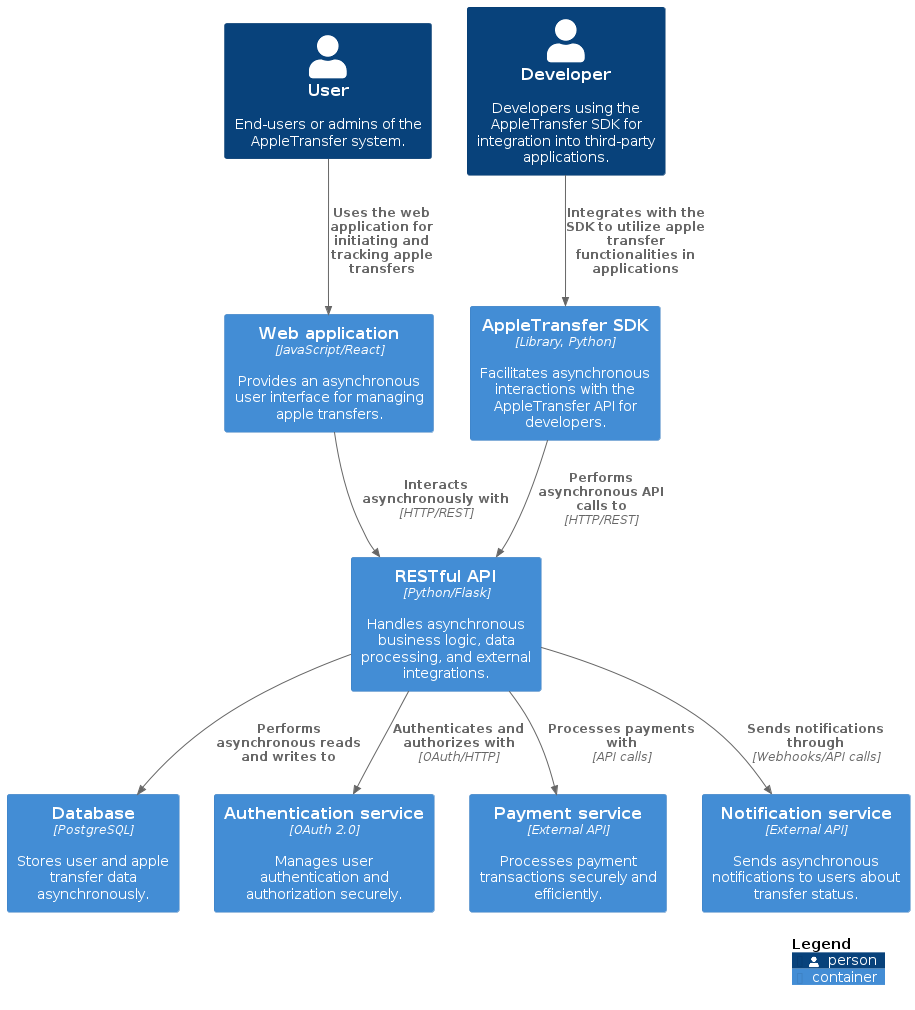AppleTransfer container architecture
1. Introduction
The AppleTransfer system is designed to streamline the process of transferring apples between various entities, providing functionalities for initiating transfers, tracking progress, and managing transactions. This document explores the container architecture of the AppleTransfer system, highlighting the asynchronous communication and interactions among the system’s components.
2. Container overview
The architecture of the AppleTransfer system is built on a series of interconnected containers, each serving a distinct role within the ecosystem. These containers work in tandem to deliver a scalable, secure, and efficient apple transfer service.

-
Web application: Developed using JavaScript/React, this user-facing application enables users to interact with the AppleTransfer functionalities asynchronously, enhancing user experience with non-blocking operations.
-
RESTful API: Powered by Python/Flask, the API layer handles the system’s business logic, data processing, and interactions with external services, all through asynchronous requests to ensure high performance and responsiveness.
-
Database: Utilizing PostgreSQL, this container stores essential data such as user profiles, apple transfer records, and transaction logs, supporting synchronous and asynchronous data operations for flexibility and efficiency.
-
Authentication service: This external OAuth 2.0 service manages user authentication and authorization, secures system access, and protects sensitive information.
-
Payment service: An external API that securely processes payment transactions related to apple transfers, integrating seamlessly with the RESTful API for financial operations.
-
Notification service: Another external API that sends asynchronous notifications to users about their apple transfer status, alerts, and other pertinent information, contributing to an engaged and informed user base.
-
AppleTransfer SDK: A Python library that provides developers the tools to integrate AppleTransfer functionalities into third-party applications, facilitating asynchronous API calls for smooth and efficient integration.
3. Interactions and integrations
3.1. User interactions
End-users and administrators interact with the AppleTransfer system primarily through the web application. This interface allows them to send apples, track transfer statuses, and manage their accounts, all within an asynchronous framework for enhanced user experience.
3.2. Developer integrations
Developers can integrate AppleTransfer functionalities into their applications using the AppleTransfer SDK. This SDK simplifies making asynchronous calls to the RESTful API, enabling developers to leverage the system’s capabilities within their software solutions.
3.3. System communications
The web application and SDK interact asynchronously with the RESTful API to initiate and manage apple transfers. The RESTful API, in turn, communicates with the database for data persistence, the authentication service for secure access, the payment service for transaction processing, and the notification service for user alerts, ensuring a cohesive and secure operational flow.
4. Conclusion
The container architecture of the AppleTransfer system illustrates a modern approach to application design, emphasizing asynchronous communication, security, and scalability. By delineating functionalities across distinct containers, the system ensures robust performance, secure data handling, and a seamless user experience, making it an exemplary model for managing and integrating apple transfer processes.